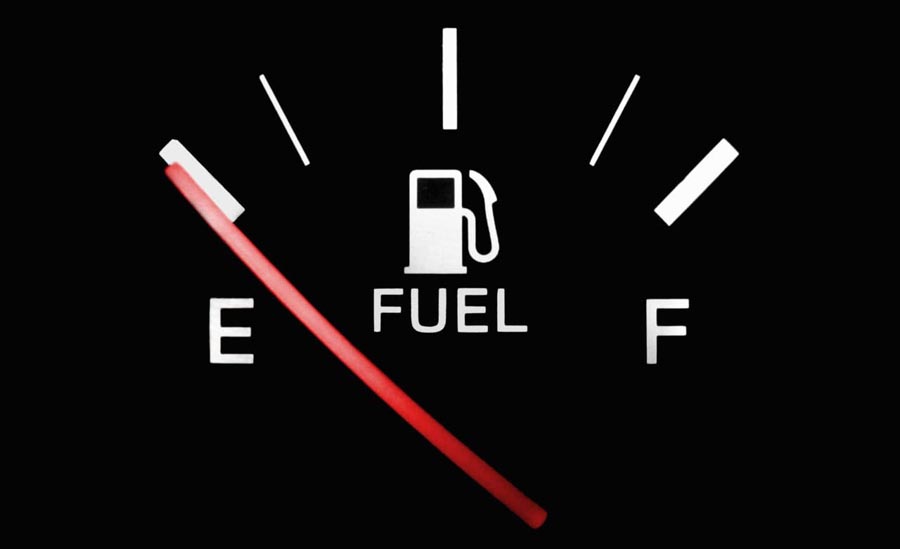
The question of how much gas a snow blower holds is a very important one.
As much as we try and do our best to ensure we keep our snow blower topped up with fuel, there might be occasions when we simply forget!
And if a big storm is on its way, there is nothing worse than your snow blower running out of gas halfway through the job…
In this article, we take a closer look at snow blower gas tanks, and how long you can reasonably expect a full tank of gas to last.
So let’s get started…
How Much Gas Does A Snow Blower Hold?
Snow blowers hold somewhere between 0.35 gallons (1.7 qts) and 1.5 gallons (7.2 qts) of gas. It varies from type to type and brand to brand, but generally, as snow blowers get more powerful, the gas tank capacity will increase as well. There is a trade-off though because at the same time, more powerful snow blowers will burn off fuel more quickly.
Snow Blower Gas Capacity: An In-Depth Analysis
Now there obviously isn’t one answer when it comes to the question of how much gas a snow blower holds.
It will vary from brand to brand, model to model and type to type.
Some of you will have big three-stage snow blowers, others of you will have much smaller single-stage blowers.
So to get the most comprehensive answer to the question, we need to consider all possible options, and luckily for you that is just what we have done!
Let’s begin with…
Single Stage Snow Blowers
18-Inch Clearing Width
- Toro Power Clear® 518 ZR (Model No: 38474): 0.35 gallons (1.7 qts)
- Toro Power Clear® 518 ZE (38475): 0.35 gallons (1.7 qts)
21-Inch Clearing Width
- Toro Power Clear® 821 R-C (38755): 0.78 gallons (3.75 qts)
- Toro Power Clear® 721 R-C (38754): 0.56 gallons (2.69 qts)
- Cub Cadet 1X (31PM2T6C710): 0.5 gallons (2.4 qts)
- Troy-Bilt Squall 179E (265-JUA): 0.5 gallons (2.4 qts)
- Craftsman SB230 (22101500): 0.5 gallons (2.4 qts)
22-Inch Clearing Width
- Toro SnowMaster 824 QXE (36003): 0.8 gallons (3.84 qts)
- Toro SnowMaster 724 QXE (36002): 0.575 gallons (2.76 qts)
- Simplicity 1022 (1697143-00): 0.8 gallons (3.84 wts)
24-Inch Clearing Width
- Toro SnowMaster 824 QXE (36003): 0.8 gallons (3.84 qts)
- Ariens Platinum 24 SHO (921063): 0.74 gallons (3.55 qts)
- Cub Cadet 2X (31AM6HVRB10): 0.5 gallons (2.4 qts)
- Honda HSS724A (HSS724AAWD): 0.82 gallons (3.94 qts)
- Husqvarna ST424 (ST424): 0.62 gallons (2.98 qts)
RELATED ===> Buyers Guide: The Best Snow Blowers on the Market
Two Stage Snow Blowers

24 to 25 Inch Clearing Width
- Ariens Platinum 24 SHO (921063): 0.74 gallons (3.55 qts)
- Cub Cadet 2X (31AM6HVRB10): 0.5 gallons (2.4 qts)
- Honda HSS724A (HSS724AAWD): 0.82 gallons (3.94 qts)
- Husqvarna ST424 (ST424): 0.62 gallons (2.98 qts)
- Simplicity 1024 (1696811-02): 0.8 gallons (3.84 qts)
- Troy-Bilt Storm 2420 (270-WUB): 0.5 gallons (2.4 qts)
- Craftsman SB410 (31AS68EE791): 0.375 gallons (1.7 qts)
26 to 27 Inch Clearing Width
- Simplicity 1227 (1696819-02): 0.8 gallons (3.84 qts)
- Troy Bilt Storm 2620 (675-WUB): 0.5 gallons (2.4 qts)
28 to 29 Inch Clearing Width
- Cub Cadet 2X (31AH5IVTB10): 0.75 gallons (3.6 qts)
- Ariens Professional Alpine RapidTrak®: 0.74 gallons (3.55 qts)
- Troy-Bilt Storm Tracker 2890: 0.75 gallons (3.6 qts)
30 to 32 Inch Clearing Width
- Ariens Platinum 30 SHO (921064): 0.74 gallons (3.55 qts)
- Cub Cadet 2X (31AH5GVO710): 1.25 gallons (6 qts)
- Simplicity 1530 (1696832-02): 0.8 gallons (3.84 qts)
- Ariens Professional (926082): 0.74 gallons (3.55 qts)
- Troy-Bilt Storm 3090 (683 WUB): 1.25 gallons
RELATED ===> Why Is My Snow Blower Leaking Gas?
Three Stage Snow Blowers
26 Inch Clearing Width
- Cub Cadet 3X (3X26″ TRAC): 1.25 gallons (6 qts)
- Cub Cadet 3526SWE – 3X (31AH5DVA710): 1.25 gallons (6 qts)
- Troy-Bilt Vortex 2610 (683-WUB): 1.25 gallons (6 qts)
28 Inch Clearing Width
- Craftsman SB650 (22101500): 1.5 gallons (7.2 qts)
30 Inch Clearing Width
- Cub Cadet 3XHD (3X30″ HD): 1.25 gallons (6 qts)
Now the list above is comprised entirely of walk-behind snow blowers.
Ride-on snow blowers are a different matter altogether, as now we are talking tractors with the ability to add a snow plow.
For instance the Toro GrandStand® MULTI FORCE 60″ has a fuel capacity of 10.5 gallons (42 qts).
But as you can see the number of gallons of gas a walk-behind snow blower holds varies, but unsurprisingly increases as a snow blower increases in size and power.
We can say that walk-behind snow blowers hold between 0.35 gallons (1.7 qts) and 1.5 gallons (6 qts) of gas.
By comparison, a small car usually holds somewhere around 12 gallons (48 qts) of gas.
How Much Gas Does a Snow Blower Use?

It is all very well knowing how much gas your snow blower holds, but it is also helpful to know how fast it will use the gas.
Like any gas-powered machine, there are a few variables and it depends upon how you operate it. But the higher the HP rating the faster it will use gas.
Now there is an equation that is widely used to calculate fuel consumption in engines.
I hope you have your calculator/abacus/pen and paper ready, as it might be a bit confusing, so I will attempt to explain it as best I can!
It is estimated that 0.4lb of fuel is used per unit of horsepower per hour. There are 6.5lb of gasoline per gallon.
RELATED ===> Should You Store Your Snow Blower With Or Without Gas?
So we know from the section above snow blowers hold somewhere between 0.35 gallons and 1.5 gallons of gas. That equates to 2.275 lbs and 9.75 lbs of gasoline.
Let’s use the Simplicity 1530 snow blower as an example. That has 14.5hp and a 0.8-gallon tank, 0.8 gallons of fuel is 5.2 lbs (6.5 times 0.8).
Based on the equation above a 14.5HP snow blower will use 5.8 lbs of gas per hour (0.4lbs times 14.5).
That means it will likely use all of its fuel tank in less than an hour.
Is that clear?!
I hope so!
It gets even more confusing when engines are measured in CC, but this handy CC to HP converter should help.
Here is how many lbs of gas a snow blower will use per hour based upon its horsepower using the above calculation:
- 1HP: 0.4lbs
- 2HP: 0.8lbs
- 5HP: 2lbs
- 10HP: 4lbs
- 15HP: 6lbs
- 20HP: 8lbs
And here is how gas tank volume equates from gallons/quarts to lbs of gas:
- 0.35 gallons/1.7 qts: 2.275 lbs
- 0.5 gallons/2.4 qts: 3.25 lbs
- 0.75 gallons/3.6 qts: 4.875 lbs
- 1 gallon/4 qts: 6.5 lbs
- 1.25 gallons/6 qts: 8.125 lbs
- 1.5 gallons/7.2 qts: 9.75 lbs
It isn’t an exact science, and it is a bit confusing, but it does give at least a rough idea of how long you might expect a full tank of gas to last on your snow blower.
A snow blower will consume more fuel if it is clearing wet and heavy snow compared to light and fluffy snow as well, so that is something else to consider.
It is always handy to have a spare container of ethanol-free gas (with stabilizer) in it, to hand so if your snow blower does run out of fuel you can quickly replace it and get on with the job.
Final Thoughts

Answering the question of how many gallons of gas a snow blower holds is the easy question!
It will be somewhere between 0.35 gallons (1.7 qts) and 1.5 gallons (7.2 qts), and will vary depending upon the size of the snow blower as show on the infographic above.
Estimating how quickly it will use that gas is more tricky and does require a few calculations.
What we can say for definite is that the higher the horsepower the quicker a snow blower will use the gas.
For instance, a 5HP snow blower will use somewhere around 2lbs of gas per hour, whereas a 15HP snow blower will use around 6lbs of gas per hour.
But usually as snow blowers increase in power they have bigger gas tanks, so it is a bit of a trade-off.
Hopefully this article has given you enough information to work out roughly how long a full tank of gas should last you.
But to be on the safe side, always make sure you always have spare fuel stored and ready to use just in case of an emergency.
